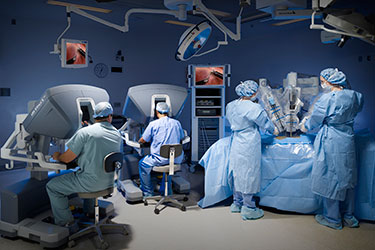Robotic surgery is used in minimally invasive procedures and helps to aid in precision, control and flexibility. During robotic surgery, surgeons can perform very complex procedures that are otherwise either highly difficult or impossible. As the technology improves, it can be combined with augmented reality to allow surgeons to view important additional information about the patient in real time while still operating.
When performing robotic surgery using the da Vinci Surgical System:
- The surgeon works from a computer console in the operating room, controlling miniaturized instruments mounted on three robotic arms to make tiny incisions in the patient.
- The surgeon looks through a 3-D camera attached to a fourth robotic arm, which magnifies the surgical site.
- The surgeon’s hand, wrist and finger movements are transmitted through the computer console to the instruments attached to the robot’s arms. The mimicked movements have the same range of motion as the surgeon allowing maximum control.
- The surgical team supervises the robot at the patient’s bedside.
ADVANTAGES:
Surgeons who use the robotic system find that for many procedures it enhances precision, flexibility and control during the operation and allows them to better see the site, compared with traditional techniques.
Often, robotic surgery makes minimally invasive surgery possible. The benefits of minimally invasive surgery include:
- Fewer complications, such as surgical site infection
- Less pain and blood loss
- Quicker recovery
- Smaller, less noticeable scars.

References: Lanfranco, A. R., Castellanos, A. E., Desai, J. P., & Meyers, W. C. (2004). Robotic surgery: a current perspective. Annals of surgery, 239(1), 14-21.